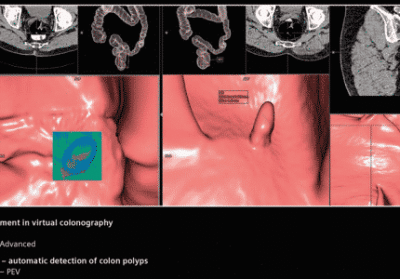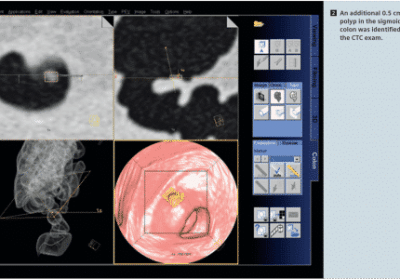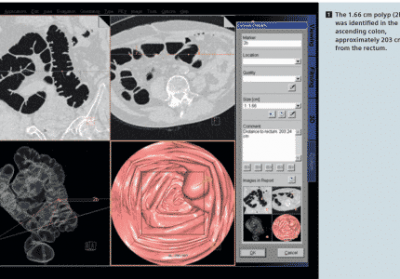Colorectal Cancer Screening
Colorectal cancer is the second deadliest type of cancer in developed countries. Early disease detection greatly improves the survival rate. In its July 2016 report, US Preventive Services Task Force (USPSTF) included CT colonography (CTC – virtual colonoscopy) as an equally valuable method for colorectal cancer screening among seven acceptable screening options. Approved screening methods are colonoscopy, fecal immunochemical test (FIT), for occult bleeding, sigmoidoscopy + FIT and CT colonography. Fecal immunohistochemical DNA test, guaiac test for occult bleeding and sigmoidoscopy by itself are inferior in comparison with the first four methods. With proper bowel preparation, new CT colonography studies have shown CTC sensitivity and specificity in discovering lesions that are 6mm or larger to be comparable to colonoscopy (sensitivity: 73-98% and specificity: 89-90%).
CT colonography (virtual colonoscopy) is done with the help of modern CT devices that enable the imaging of colon convolutions after air or carbon dioxide spreading. Prerequisite for the examination are thoroughly cleansed bowels using a high amount of liquid in combination with laxative. After computer imaging, reconstructions of inner bowel surface are also analyzed.
Main advantages of CTC are its minimal invasiveness, short procedure time and the capability to image all parts of the bowel. Disadvantages are exposure to low radiation level, inability to take samples and the potential remains of stool in the bowel that disables quality examination, same as in case with classic colonoscopy. Colonoscopy is required for the final histological evaluation or polyp removal.
Preparing for the screening
Given that in virtual colonoscopy, imaging is crucial, it is extremely important to empty the colon and rectum before examination. This means that you will need to follow a specially prescribed liquid diet for one to three days before the examination.
Procedure
The examination with a virtual colonoscopy takes place in a special room with a CT device. Your doctor may ask you to drink a contrast mixture before the examination so that any remaining stool in the colon and rectum can be "marked". During the examination, you will be asked to lie down on a bed that is part of a CT device and your doctor will insert a small flexible tube into your anus. When you are ready, air will begin to be pumped through the tube into the column to expand it, resulting in better computer displays. The bearing is then moved inside the CT machine to take a series of views of each part of your column. The CT machine will take two types of displays - one while lying on your back and one while you are on your stomach. The total examination time by virtual colonoscopy is only 10 minutes.
What if cancer is found?
If your doctor finds an abnormal growth, he or she will refer you for a conventional colonoscopy to remove it. There is also the possibility that a CT scan will detect something outside the column that will require additional testing.
After the screening
Since no anesthesia is used during the examination, the patient can return to normal daily activities immediately after the examination, without the need for assistance from another person. Virtual colonoscopy usually has very few side effects. It is common for any feelings of bloating as well as cramps to go away after the excess air comes out of the body. There is very little possibility that inflating the colon will cause it to be damaged or ruptured, but the risk of this is incomparably lower than with conventional colonoscopy. Like all types of CT scans, this scan exposes you to a small amount of radiation.
How often should you go for a checkup?
It is recommended that the examination be performed every five years after the age of fifty
syngo Colonography CT
syngo Colonography CT is a clinical application used for non-invasive examination of the entire colon based on low-dose and high-resolution spiral CT scans.
The USPSTF recommends that screening procedures for colorectal cancer be performed by CT colonography every five years between the ages of 50 and 75. Find out more information on the official website.
Advantages:
- Synchronized dual real-time display and scan analysis (eg in the abdominal and back position or in front and post-contrast) of up to two monitors
- Support for dual monitors
- Synchronized refresh of endoscopic, axial and global examinations
- Superior real-time virtual endoscopy display quality, using highly efficient plotting techniques
- Fully automated centered navigation
- Automatic labeling and elimination of the small intestine from the display
- View of the entire colon for easier viewing of a trajectory similar to that with a solid or barium-based enema
- An overview segment containing the trajectory and marked pathological findings
- Measuring polyp size
- Panoramic endoscopic examination of the colon that allows the user to examine the colon from both directions, allowing an examination of the area behind the fold as it moves in one direction.
- Instant collection of all findings and key views in Findings Navigator
- Storing and transferring the findings of potential changes is also done with the help of Findings Navigator
The app combines the benefits of 2D and 3D benefits of colon analysis and provides fully automated centered navigation and high-speed real-time fly-through navigation with a high-quality virtual endoscopy technique. Flexible display settings and support for dual monitors allow an instant transition between the 3D endoscopic view and the corresponding 2D view. Furthermore, the physician can select a synchronized transition both in the supine and abdominal positions while at the same time collecting the findings.



Clinical applications
CT colonography has become a routine tool for colon oncology assessments. Virtual colonoscopy is a particularly appropriate method in the case of a failed or incomplete conventional colonoscopy that could not be performed due to cancer, risk of bleeding, or wall perforation.
The results of ACRIN clinical trials published in The New England Journal of Medicine have shown that virtual colonoscopy, ie computed tomography, is just as effective in finding colorectal cancer and large polyps as traditional colonoscopy.
The American Cancer Society added CT colonography to its list of recommended colon cancer screening and prevention screenings in March 2008, and recommends CT colonography screening every five years.
syngo.CT colonography can be used in combination with low-dose spiral abdominal CT examination for preventive examinations of the colon as well as diagnostic examinations in cases where the patient has failed optical colonoscopy or when optical colonoscopy cannot be performed due to cancer or bleeding disorders and when there is risk of colonic wall perforation.
syngo.CT Colonography Advanced
syngo.CT Colonography Advanced provides a sophisticated Polyp Lens Tool for CT colonography that supports the differentiation of polyps from residual stool, lipoma, and other structures.
syngo.CT Colonography PEV
syngo.CT Colonography PEV (Polyp Enhanced Viewing) is a fully automated second reading program that is computer-assisted and optional for syngo.CT colonography and comes as part of the CT Oncology Engine Pro program. The results are automatically pre-processed into data groups for positions in the back and abdomen immediately after being sent to syngo.via and are ready for analysis as soon as the patient's file is loaded.
___
1. US Preventive Services Task Force. Screening for Colorectal Cancer: US Preventive Services Task Force Recommendation Statement. JAMA. 2016;315(23):2564-2575. doi:10.1001/jama.2016.5989